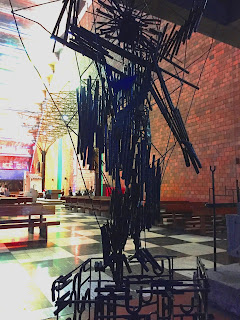The Way of the Cross
For many Christians, the tradition of meditating upon the stations of the cross is a meaningful spiritual practice during Lent, particularly during Holy Week. The stations of the cross represent physical locations and events which took place in Jerusalem. Tradition holds that Mary, the Mother of Jesus, walked the Via Dolorosa (Via Crucis or Way of the Cross). At the time of Emperor Constantine, the stations along the Way of the Cross were publicly marked, and in the centuries which have followed, pilgrims have sought to walk in the footsteps of Jesus not only in Jerusalem, but in sanctuaries and chapels throughout the Christian world.
During the first week of Lent we had the opportunity to visit El Rosario Church (Church of the Rosary) in San Salvador. The stone and iron sculptures which depict the different stations capture the moments of violence and submission within the Way of the Cross. These constructs of spiritual art were created by Ruben Martinez, the sculptor and architect who designed El Rosario Church. Construction was completed in 1971. There is symbolism woven into every aspect of the church. The 14 stations of the cross are set in a u-shaped form, under a low ceiling at one end of the sanctuary. Darkness and concrete seats invite visitors to pause for a time to reflect on the final walk which Jesus took before his death.
 1. Jesus Is Condemned to Death.
1. Jesus Is Condemned to Death.
Pontius Pilate condemns Jesus to death.

2. Jesus Takes Up His Cross.
Jesus willingly accepts and patiently bears his cross.
3. Jesus Falls the First Time.
Weakened by torments and by loss of blood, Jesus falls beneath his cross.
4. Jesus Meets His Sorrowful Mother.
Jesus meets his mother, Mary, who is filled with grief.
5. Simon of Cyrene Helps Jesus Carry the Cross.
Soldiers force Simon of Cyrene to carry the cross.
6. Veronica Wipes the Face of Jesus.
Veronica steps through the crowd to wipe the face of Jesus.
7. Jesus Falls a Second Time.
Jesus falls beneath the weight of the cross a second time.
8. Jesus Meets the Women of Jerusalem.
Jesus tells the women to weep not for him but for themselves and for their children.
9. Jesus Falls the Third Time.
Weakened almost to the point of death, Jesus falls a third time.
10. Jesus Is Stripped of His Garments.
The soldiers strip Jesus of his garments, treating him as a common criminal.
11. Jesus Is Nailed to the Cross.
Jesus’ hands and feet are nailed to the cross.
12. Jesus Dies on the Cross.
After suffering greatly on the cross, Jesus bows his head and dies.
13. Jesus Is Taken Down From the Cross.
The lifeless body of Jesus is tenderly placed in the arms of Mary, his mother.
14. Jesus Is Laid in the Tomb.
Jesus’ disciples place his body in the tomb.
The closing prayer—sometimes included as a 15th station—reflects on the Resurrection of Jesus Christ.
During the first week of Lent we had the opportunity to visit El Rosario Church (Church of the Rosary) in San Salvador. The stone and iron sculptures which depict the different stations capture the moments of violence and submission within the Way of the Cross. These constructs of spiritual art were created by Ruben Martinez, the sculptor and architect who designed El Rosario Church. Construction was completed in 1971. There is symbolism woven into every aspect of the church. The 14 stations of the cross are set in a u-shaped form, under a low ceiling at one end of the sanctuary. Darkness and concrete seats invite visitors to pause for a time to reflect on the final walk which Jesus took before his death.
 1. Jesus Is Condemned to Death.
1. Jesus Is Condemned to Death.Pontius Pilate condemns Jesus to death.

2. Jesus Takes Up His Cross.
Jesus willingly accepts and patiently bears his cross.
3. Jesus Falls the First Time.
Weakened by torments and by loss of blood, Jesus falls beneath his cross.
4. Jesus Meets His Sorrowful Mother.
Jesus meets his mother, Mary, who is filled with grief.
5. Simon of Cyrene Helps Jesus Carry the Cross.
Soldiers force Simon of Cyrene to carry the cross.
6. Veronica Wipes the Face of Jesus.
Veronica steps through the crowd to wipe the face of Jesus.
7. Jesus Falls a Second Time.
Jesus falls beneath the weight of the cross a second time.
8. Jesus Meets the Women of Jerusalem.
Jesus tells the women to weep not for him but for themselves and for their children.
9. Jesus Falls the Third Time.
Weakened almost to the point of death, Jesus falls a third time.
10. Jesus Is Stripped of His Garments.
The soldiers strip Jesus of his garments, treating him as a common criminal.
11. Jesus Is Nailed to the Cross.
Jesus’ hands and feet are nailed to the cross.
12. Jesus Dies on the Cross.
After suffering greatly on the cross, Jesus bows his head and dies.
13. Jesus Is Taken Down From the Cross.
The lifeless body of Jesus is tenderly placed in the arms of Mary, his mother.
14. Jesus Is Laid in the Tomb.
Jesus’ disciples place his body in the tomb.
The closing prayer—sometimes included as a 15th station—reflects on the Resurrection of Jesus Christ.
















Comments
Post a Comment